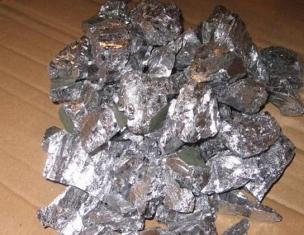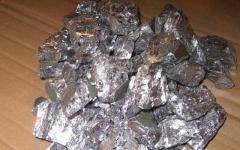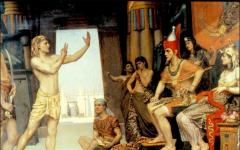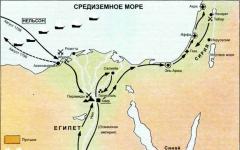Palace coups- period in history Russian Empire XVIII century, when the highest state power was achieved through palace coups carried out with the help of the guard or courtiers. In the presence of absolutism, this method of changing power remained one of the few ways of influence of society (the noble elite) on the supreme power in the state.
The origins of palace coups should be sought in the policies of Peter I. Published "Decree on succession to the throne" (1722), he maximized the number of potential candidates for the throne. The current monarch had the right to leave anyone as heir. If he did not do this, the question of inheriting the throne remained open.
In the political situation that developed in Russia in the 18th century, coups performed a regulatory function in the relationship between the key systems of absolutism - the autocracy, the ruling elite and the ruling nobility.

Brief chronology of events
After the death of Peter I, his wife reigned Catherine I(1725-1727). Created under her Supreme Privy Council (1726), who helped her in governing the country.
Her heir Peter II(1727-1730), grandson of Peter I, moved the capital of Russia from St. Petersburg to Moscow.
The Supreme Privy Council, having forced the signing of “conditions” - conditions limiting the power of the monarch (1730), invited Anna Ioannovna(1730-1740), Duchess of Courland, daughter of Ivan V, to the Russian throne. The future empress first accepted them and then rejected them. The time of her reign is known as "Bironovism" (name of her favorite). Under her, the Supreme Privy Council was liquidated, the decree on single inheritance was canceled (1730), the Cabinet of Ministers was created (1731), the Gentry Corps was created (1731), the term of noble service was limited to 25 years (1736).
In 1740 he inherits the throne five month nephew of Anna Ioannovna Ivan VI(1740-1741) (regents: Biron, Anna Leopoldovna). The Supreme Privy Council has been restored. Biron reduced the amount of the poll tax, introduced restrictions on luxury in court life, and issued a manifesto on strict observance of the laws.
In 1741, Peter's daughter - Elizabeth I(1741-1761) carries out another coup d'état. Liquidates the Supreme Privy Council, abolishes the Cabinet of Ministers (1741), restores the rights of the Senate, abolishes internal customs duties (1753), creates the State Loan Bank (1754), a decree is passed allowing landowners to send peasants to settle in Siberia (1760).
From 1761-1762 ruled by nephew of Elizabeth I, Peter III. He issues a decree on the secularization of church lands - this is the process of turning Church property into state property (1761), liquidates the Secret Chancellery, and issues a Manifesto on the freedom of the nobility (1762).
Main dates:
1725-1762 - era of palace coups
1725-1727 - CATHERINE I (second wife of Peter I), years of reign.
1727-1730 — PETER II (son of Tsarevich Alexei, grandson of Peter I), years of reign.
1730-1740 - ANNA IOANNOVNA (niece of Peter I, daughter of his brother-co-ruler Ivan V)
1740-1741 - IVAN VI (second cousin, great-grandson of Peter I). Regency of Biron, then Anna Leopoldovna.
1741-1761 — ELIZAVETA PETROVNA (daughter of Peter I), years of reign
1761-1762 - PETER III (grandson of Peter I and Charles XII, nephew of Elizaveta Petrovna).
Table "Palace coups"

Personalities of the period of palace coups
The period of palace coups is a bright page in the history of Russia. History is made by people. The article provides information about the most famous personalities of this period - statesmen and military leaders, leaders of popular uprisings.
On the Unified State Examination in history there are tasks No. 18-19, which can ask questions about portraits famous personalities. It will be necessary either to find out what kind of people they are, or to identify someone who was a contemporary of the ruler discussed in task No. 18. Therefore, look closely at the faces of these people from that distant eras - eras palace coups. They were the contemporaries of Anna Ioannovna, Elizaveta Petrovna, and Catherine II. It was thanks to many of them that Russia became a powerful and strong power.
|
Personalities |
Activity. |
|
Biron E.I. (1690-1772)
|
Favorite Anna Ioannovna. Significantly influenced the external and domestic policy. After the death of the empress he was removed. Sent into exile. Peter III returned him to St. Petersburg; under Catherine II he was Duke of Courland. (Cm. historical portrait Birona on the website: : istoricheskiy - portrait . ru ) |
|
Buturlin A.B. (1694-1767)
|
Commander-in-Chief of the Russian army in the Seven Years' War in 1760-1761. From 1762 - Moscow Governor-General. |
|
Vorontsov M.I. (1714-1767)
|
Participant in the palace coup of 1741. Headed Russian foreign policy under Elizaveta Petrovna, senator, chancellor. |
|
Vorontsov R.I. (1707- 1783)
|
Statesman, senator, since 1760 - Chairman of the Statutory Commission. His daughter Catherine was the favorite of Peter III, so Vorontsov himself was the most influential figure during the reign of Peter III. |
|
Golitsyn D.M. (1665-1737)
|
One of the initiators of the invitation to the throne of Anna Ioannovna and the limitation of her power by the Supreme Privy Council. In 1737 - deprived of all ranks, imprisoned in the Shlisselburg fortress, and died there. |
|
Golovkin G.I. (1660-1734)
|
In 1726-1730 - member of the Supreme Privy Council, opponent of Menshikov. He destroyed the will of Catherine I, according to which the throne was transferred to the daughters of Peter I, was the initiator of the invitation to the throne of Anna Ioannovna, and under her, until her death, he was the first cabinet minister. |
|
Dashkova E.R. (1744 – 1810)
|
Princess, active participant in the coup of 1762. Took part in the creation of Volny Russian meeting at Moscow University. From 1783 - director of the St. Petersburg Academy of Sciences. Since the same 1783 - President of the Russian Academy. In 1796, Paul I sent her into retirement, then into exile. After his death, she was engaged in charity and scientific activities. |
|
Dolgorukov V.M. (1722-1822)
|
Military leader, prince. Participated in the war with Sweden in 1741-1743, led the capture of Crimea in 1771, for which he received the title Crimean. From 1780 - commander-in-chief in Moscow. |
|
Kosciuszko Tadeusz (1746-1817)
|
Leader of the Polish uprising in 1794. |
|
Minikh B.K. (1683-1767)
|
In Russian service since 1713. Under Anna Ioannovna, President of the Military Collegium. Commanded the Russian army in the war with Turkey in 1735-1739. Later political influence didn't have. |
|
Orlov A.G. (1737-1808)
|
Statesman and military leader. An active participant in the coup of 1762, one of the influential figures under Catherine II. Commander-in-Chief of the fleet in the war with Turkey, won a victory in 1770 at Chesma. Received the title prince Chesmensky. He developed a breed of Oryol trotters. During the period of power of Paul I he was abroad and returned in 1801. |
|
Orlov G.G. (1734 – 1783)
|
Military and statesman, favorite of Catherine II, one of the leaders of the coup of 1762. The count, commander of the artillery, led the suppression of the plague riot in Moscow in 1771. Initiator of creation and first president Free Economic Society since 1765. In 1775 he retired and went abroad. |
|
Osterman A.I. (1686-1747)
|
In Russian service since 1703, member of the Supreme Privy Council, educator and mentor of Peter II. Since 1731 - de facto leader of the internal and foreign policy Russia. After the coup of 1741 he was exiled to Berezov. |
|
Panin N.I. (1718-1783)
|
Statesman, participant in the coup of 1762 Pavel's teacher, headed the College of Foreign Affairs in 1763-1781. |
|
Panin P.I. (1721-1789)
|
Military leader, participant in the Seven Years' War and the wars with Turkey, in 1774 he led the troops, suppressed the Pugachev uprising. |
|
Poniatowski Stanislaw August (1732-1798)
|
The last Polish king, reigned 1764-1795. In politics he focused on Russia. |
|
Potemkin G.A. (1739-1791)
|
Statesman and military leader favorite Catherine II. Participant in the palace coup of 1762. From 1774 - President of the Military Collegium. Participant Turkish war 1768-1774.Suppressed Pugachev's uprising. In 1775 he initiated the liquidation of the Zaporozhye Sich. In 1783 he achieved annexation Crimea to Russia, received the title Tauride. Supervised the creation Black Sea Fleet. Commander-in-Chief of the army in the war with Turkey in 1787-1791, under his command were Suvorov A.V., Kutuzov M.I. Ushakov F.F. |
|
Pugachev Emelyan (? 1740- 1775)
|
Leader Peasant War , originally from the Cossacks. Under the name of Peter III, he led the uprising of the Yaik Cossacks in August 1773, in September 1774 he was extradited by the conspirators, and in 1775 he was executed in Moscow on Bolotnaya Square. (See the historical portrait of Pugachev on the website: : istoricheskiy - portrait . ru ) |
|
Razumovsky A.G. (1728-1803)
|
The last hetman of Ukraine. From 1746-1765 - President of the St. Petersburg Academy of Sciences. Supported Lomonosov M.V., under Catherine II - Member State Council. |
|
Rumyantsev-Zadunaisky P.A. (1725 – 1796)
|
An outstanding commander. Participant in all Russian wars since 1741. One of the organizers of the Russian regular army, creator of new forms of combat. Outstanding military theorist. His works: “Instructions”, 1761; “Rite of Service”, 1770; "Thoughts", 1777. They served as military training aids. |
|
Salavat Yulaev (1752-1800)
|
Bashkir national hero, associate of Pugachev. In 1774 he was captured and sent to eternal hard labor. |
|
Saltykov P.S. (1698-1772)
|
Military leader, participated in the war with Poland in 1734, with Sweden in 1741-1743... in the Seven Years' War he commanded troops in 1759-1760, and won a number of victories. From 1764 - Governor-General of Moscow. Dismissed after the plague riot in 1771. |
|
Suvorov A.V. (1730-1800)
|
Great Russian commander, Count of Rymnik (from 1789), Prince of Italy (from 1799), Generalissimo (from 1799). Participant in the Seven Years' War of 1756-1763 and the wars with Turkey under Catherine II, won a number of victories. In 1799 he brilliantly conducted the Swiss and Italian campaigns. Author of military theoretical works: "The Science of Winning"" and "Regimental establishment". He did not lose a single battle, his strategy was offensive. (See the historical portrait of Suvorov A. on the website: : istoricheskiy - portrait . ru ) |
|
Ushakov F.F. (1744-1817)
|
Outstanding Russian naval commander, admiral from 1799. Participant in both wars with Turkey under Catherine II. |
|
Cherkassky A.M. (1680-1742)
|
He held major government positions under Anna Ioannovna and supported her. And after her death in 1740 he was appointed chancellor. |
|
Shuvalov P.I. (1710-1762)
|
Actual head of government under Elizaveta Petrovna. In the 50s he determined the internal policy of Russia, which was based on the ideas of “enlightened absolutism”. Author of many reforms in economics and finance, participated in the reorganization of the army. |
The material was prepared by Vera Aleksandrovna Melnikova
15 Russia in 1725-1801.
The era of palace coups
After the death of Peter I, the era of palace coups began in Russia, when power passed from one noble group to another, without changing the nature of autocracy. The dispute about the ruler of Russia was often decided by the guard regiments, on which it largely depended on who would occupy the throne.
Peter I died without appointing a successor. This issue had to be decided by the Senate, Synod and generals. Noble boyars, faithful to the traditional custom of succession to the throne, wanted to see the son of Tsarevich Alexei, the young Peter, on the throne. The new aristocracy, which emerged under Peter I, wanted to proclaim Catherine, the widow of Peter I, empress. The choice of the guards turned out to be decisive. The Senate was forced to proclaim Catherine empress.
Catherine I (1725-1727), who ascended the Russian throne, was a poorly educated woman who was unable to rule a huge empire. Even after becoming empress, she did not want to learn to read and write. Nevertheless, she was popular in the army with many supporters of Peter’s reforms. The de facto ruler under Catherine I was Peter I's associate A.D. Menshikov. He proved himself to be a talented, but greedy and unprincipled statesman.
Catherine I could not and did not want to regularly engage in state affairs. That is why in February 1726 a new highest government body was formed - the Supreme Privy Council. Formally, it had only an advisory character, but in fact it decided all the most important state affairs.
The Supreme Privy Council abandoned some of the reforms of Peter I. Under the pretext of cutting costs for the state apparatus, the Chief Magistrate was eliminated. City and provincial magistrates and town halls began to be headed by governors. Judicial and administrative power in the provinces was transferred to governors, and in provinces and districts - to governors. The capitation tax was reduced. The customs tariff of 1724 was partially revised and duties on a number of imported goods were reduced.
After the death of Catherine I in 1727, according to her will, Peter II, the 11-year-old grandson of Peter I, ascended the throne. He reigned in 1727-1730. In an effort to strengthen his influence in the state, Menshikov tried to marry Tsarevich Peter to his 15-year-old daughter Maria. In May 1727, the engagement was announced. As the emperor's father-in-law, Menshikov expected to remain the de facto ruler of the country.
A struggle developed between Menshikov and the Dolgoruky princes for influence over the young emperor. The Supreme Privy Council, which continued to hold power under Peter II, decided in September 1727 to arrest Menshikov. He was accused of high treason and theft of the treasury. In fact, it was another palace coup. Deprived of ranks, titles and orders, Menshikov was exiled with his entire family to Siberia, to the Berezov fortress, where he died in 1729.
The composition of the Supreme Privy Council was changed and turned into a government body, the final word in which belonged to the old noble nobility. The Council now had 8 members, including four princes Dolgoruky and two princes Golitsyn. Peter II practically did not take part in government affairs. In January 1728 imperial court moved from St. Petersburg to Moscow. Some boards were also transferred there. Construction was stopped navy.
The Dolgoruky princes tried to consolidate their influence on Peter II by marrying him to Catherine, the 17-year-old daughter of A.G. Dolgoruky. However, on January 18, 1730, in the 15th year of his life, a few days before his wedding, Peter II died suddenly. He didn't leave a will. With his death, the direct male line of the Romanov family was cut short. The issue of the heir to the throne had to be decided by members of the Supreme Privy Council.
After long consultations, without the participation of members of other higher institutions, the “higher-ups” came to the conclusion that the most acceptable candidate for the throne for them was Anna Ivanovna - the middle daughter of Ivan V, half-brother of Peter I. Before ascending to the throne, she had to sign a special document - “conditions” (conditions).
According to the “conditions”, she could not, without the consent of the Supreme Privy Council, start and end wars, introduce new taxes, appoint military positions above the colonel, deprive nobles of property and give them land. Command of the guard passed to the Supreme Privy Council. The new empress had to undertake not to marry and not to appoint an heir without the permission of the “sovereigns.” In case of violation of the “standards”, Anna Ivanovna was deprived of the Russian crown.
After some thought, Anna Ivanovna agreed to everything that was demanded of her and signed the “conditions”. The announced conditions for her accession to the throne caused discontent among many nobles. The Guard also did not support the “supreme leaders”.
In Moscow, where Anna Ivanovna arrived for the coronation, she met with a group of nobles who were ready to confront the Supreme Privy Council. Convinced of the support of not only these nobles, but also the guard, Anna Ivanovna on February 25, 1730, abandoned her promises to the “supreme leaders” and declared herself an autocratic empress. The aristocracy's attempt to limit autocratic power failed.
In March 1730, the Supreme Privy Council was abolished, and its most active members were executed or sent into exile. The dominant position at court was taken by the favorite of the Empress E. I. Biron. Without holding official government positions, Biron enjoyed the unlimited trust of Anna Ivanovna. He actually directed the entire domestic and foreign policy of Russia. A. I. Osterman helped him determine the government course, and Field Marshal B. K. Minikh helped him decide all military affairs.
Anna Ivanovna was forced to expand the rights and privileges of the nobility. On March 17, 1731, she canceled the Decree on Single Inheritance, introduced by Peter I in 1714. From now on, all nobles were given complete freedom to inherit estates. Since 1731, they have been creating cadet corps, which allowed nobles to become officers, bypassing hard military service. In March 1731 it was recreated Secret Chancery- body of political investigation and court. The office was equated to a collegium and removed from the control of the Senate. In total, during the reign of Anna Ivanovna, about 10 thousand people were arrested for political reasons.
In October 1740, Anna Ivanovna died. She appointed Ivan Antonovich, the recently born son of her niece Anna Leopoldovna, as her successor to the Russian throne. Ivan VI was the great-grandson of Tsar Ivan V. Biron was appointed regent for the infant emperor until he was 18 years old. He received the right to manage all state affairs - both internal and external.
Biron's regency lasted only 3 weeks. In November 1740, another palace coup took place, led by Field Marshal B. K. Minich. Biron was arrested and exiled to Siberia. Anna Leopoldovna became regent for her young son Ivan VI. Proclaimed ruler, she actually played no role in governing the state. The government was headed first by Minich and then by Osterman.
Anna Leopoldovna's reign turned out to be short-lived. On the night of November 25, 1741, another palace coup was carried out. Elizaveta Petrovna, daughter of Peter I, was proclaimed empress.
The reign of Elizabeth Petrovna was marked by a return to the Petrine order. Russian dignitaries once again occupied the highest positions in the state. In December 1741, it was announced that the full power it had enjoyed during Peter the Great's time was being returned to the Senate. The Senate remained the highest body for legislation and public administration.
Happened further expansion rights and privileges of the nobility. The collection of taxes from the peasants was transferred to the hands of the landowners, who were assigned a monopoly right to own serfs and land. They also received the right to exile peasants to Siberia, counting them instead of recruits. In 1754, the Noble Bank was established, which provided loans to nobles on very favorable terms. In the same year, internal customs duties were abolished, which opened up wide opportunities for trade in agricultural and industrial goods.
In 1756-1763 The Seven Years' War was going on in Europe. Two coalitions took part in it. One of them included Great Britain, Portugal, Prussia and some German states, the second - France, Spain, Austria, Sweden, Saxony, Russia and most German states.
On August 19, 1757, the Russian army under the command of General S. F. Apraksin defeated the Prussian army in the battle of Groß-Jägersdorf. However, Apraksin, instead of taking advantage of this victory, gave the order to retreat from East Prussia to Lithuania. Soon the Russian army launched a new offensive. On August 1, 1759, in the general battle of Kunersdorf, Russian troops almost completely destroyed the army of the Prussian Emperor Frederick II. In September 1760, Russian troops occupied Berlin for some time. By 1761, Prussia's defeat became obvious.
On December 25, 1761, Empress Elizabeth Petrovna died, and this saved Frederick II from complete collapse.
Elizaveta Petrovna had no children, so in November 1742 she declared the Duke of Holstein-Gottorp, the son of her elder sister Anna Petrovna, the heir to the Russian throne. At the age of 2 months he lost his mother, and at the age of 10 years - his father.
Karl Peter Ulrich arrived in Russia as a 14-year-old boy in 1742. In Orthodoxy, he took the name Peter Fedorovich. Becoming Russian Emperor, Peter III took up mainly entertainment. He left government to the court nobility, who carried out a number of important reforms.
In February 1762, a Manifesto was published on the abolition of the Secret Chancellery. At the same time, torture was abolished during the investigation of crimes. Shortly before this, a Manifesto was adopted on the granting of liberty and freedom to the entire Russian nobility. The manifesto abolished compulsory service for nobles - both military and civilian. They could freely travel abroad and hire themselves into the service of other sovereigns. Corporal punishment for nobles was abolished. The manifesto transformed the nobility from a serving class into a privileged class. In March 1762, a Decree was issued on the secularization of monastic and church lands.
An admirer of the Prussian emperor, Peter III immediately stopped hostilities and returned to defeated Prussia all its territories occupied by Russian troops. On April 24, 1762, Russia concluded an alliance treaty with Prussia. Thus, Peter III nullified all Russian victories in the Seven Years' War and actually saved Prussia from capitulation.
The officers and guards were very dissatisfied with the results of the war with Prussia. Peter III announced that he was going to withdraw the guard from St. Petersburg and send it to fight with Denmark. Russia did not need this war, but it corresponded to the interests of Schleswig-Holstein - the homeland of Peter III. Added to all this was Peter III’s obvious disrespect for all Russian rituals and customs, his drunkenness, and various obscene antics. The emperor's opponents took advantage of the general discontent. They were led by his wife Petra III Catherine Alekseevna.
On June 28, 1762, a palace coup took place, as a result of which Russian empress Catherine II was proclaimed. The next day, Peter III signed his abdication of the throne. Soon the deposed emperor was killed by a group of officers led by A.G. Orlov.
Many expected that Catherine II would declare herself regent for the young heir Paul, the son of Peter III, and transfer the rule to him upon reaching the age of 18. This did not happen. Thus, Catherine II made a double seizure of power. She took it from her husband and did not give it to her son.
Signs of the era of palace coups:
- Ambiguity of the system of succession to the throne. Lack of a ruler with firm rights to the throne.
- The nobility becomes the main political force in society.
- The main weapon in the struggle between various noble factions became the Guards regiments, primarily the Semenovsky and Preobrazhensky regiments.
- The main method of political struggle during this period was palace coups.
- A notable phenomenon in the political life of Russia was favoritism.
January 28, 1725 Peter I dies without leaving a will. A crisis of power arose. The new nobility, led by Menshikov, sought to place the empress on the throne - Ekaterina Alekseevna (Marta Skavronska), to whom Peter himself most likely wanted to bequeath the crown. The old nobility, led by princes Golitsyn and Dolgoruky, citing centuries-old traditions, tried to bring the young Pyotr Alekseevich to power. However, it was not so much about the candidacy of the emperor, but about which of the aristocracy groups would actually rule the country.
As a result of the palace coup, Catherine I became empress. Under her 1726 the highest ruling body was created - Supreme Privy Council. The council was led by Menshikov, Catherine’s favorite.
IN 1727 Catherine I dies, bequeathing, at the insistence of Menshikov, the throne to Tsarevich Peter. Menshikov supported his candidacy because he hoped to marry him to his daughter, thereby further strengthening his power. A.G. had the same plans. Dolgoruky, who prepared a conspiracy against Peter's favorite. For a trivial reason A.D. Menshikov was arrested and exiled to the city of Berezov, where he soon died. Preparations for the imperial wedding begin, however, a few days before it, in January 1730 Peter II, whose body was greatly weakened by alcoholism, fell ill with smallpox and died. With his death, the male line of the Romanov dynasty was interrupted.
The leaders invite the Duchess of Courland Anna Ivanovna, the niece of Peter I, the daughter of Ivan V, to the throne. The Golitsyns and Dolgorukys tried to limit her power condition(conditions) she signed to receive the crown. However, upon arrival in St. Petersburg, Anna Ivanovna quickly becomes convinced that the bulk of the nobility does not support the leaders and tears up this document. In the same year, 1730, she dissolved the Supreme Privy Council. created instead Cabinet of Ministers.
Anna Ivanovna's reign can hardly be considered successful. The narrow-minded empress spent her time in hunting and entertainment, often very cruel ( "Ice House", For example). All the highest government positions were occupied by Germans, to whom the interests of Russia were alien. Anna Biron's favorite had unlimited power - these years went down in history as Bironovism. As a result of Anna Ivanovna's reign, the army and navy fell into disrepair, and the treasury was plundered.
IN 1740 Anna Ivanovna dies, bequeathing the throne to two-month-old Ivan VI Antonovich, the son of her niece Anna Leopoldovna. Biron was appointed regent. In the same year, Minikh overthrew Biron and Anna Leopoldovna herself became regent.
IN 1741 There was a palace coup, as a result of which the youngest daughter of Peter I, Elizabeth, came to power. Ivan VI was imprisoned in the fortress and twenty-three years later he was killed there by order of Catherine II.
A very patriotic-minded Elizabeth begins the revival of the army and navy and pays attention to the development of science and education. IN 1755 g., on the initiative of M.V. Lomonosov and with the participation of P. Shuvalov and E. Dashkova, Moscow State University was opened. Abolished in 1756 death penalty. There is a ruling body under the empress Conference at the highest court.
At the same time, the courtyard is drowning in luxury, holidays, fireworks, and carnivals are held almost every day - this devastates the treasury. To please her favorite Alexei Razumovsky (a native of Ukraine), Elizabeth restores the hetmanship, abolished by Peter after Mazepa’s betrayal. Kirill Razumovsky, Alexei’s brother, becomes hetman. Russia's entry in 1757 Seven Years' War showed the relatively low combat effectiveness of the Russian army. Nevertheless, in general, Elizabeth's reign can be assessed as quite successful.
Before death, in 1761 Mr. Elizaveta Petrovna bequeaths the throne to her nephew, the son of Peter’s eldest daughter Anna, Peter III. Stupid and frivolous (the Empress herself called him the “Holstein devil”), he turned out to be incapable of governing the state. Trying to strengthen his authority, he 1762 publishes Manifesto on the freedom of the nobility, in which the compulsory service of nobles, introduced by Peter, was abolished. However, this event does not save the emperor: in the same year he is overthrown and soon killed. His wife, Catherine II, becomes empress.


































